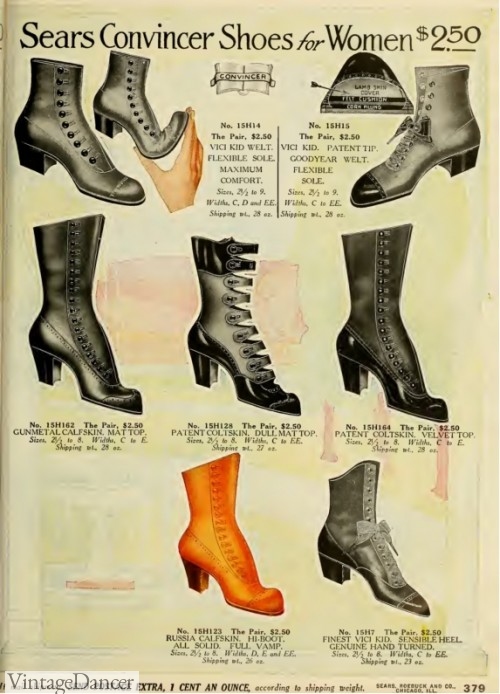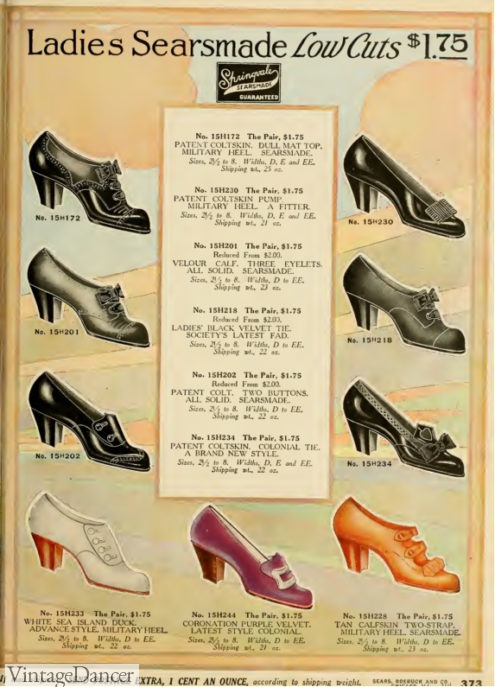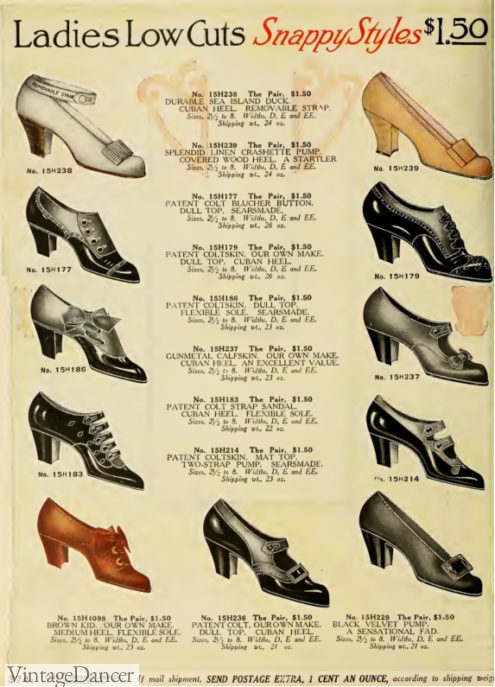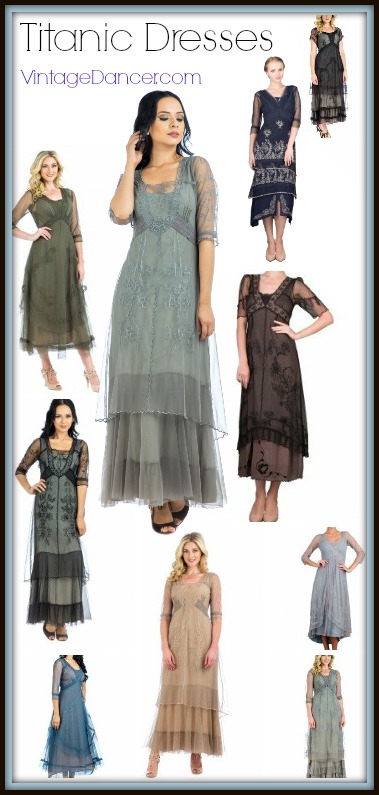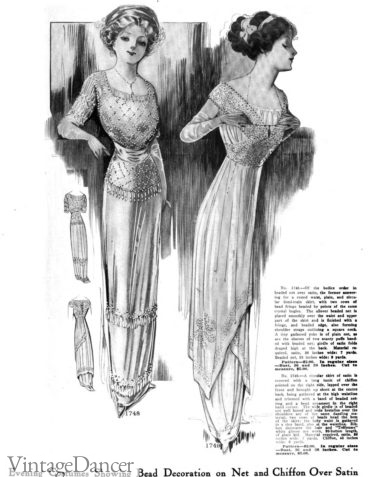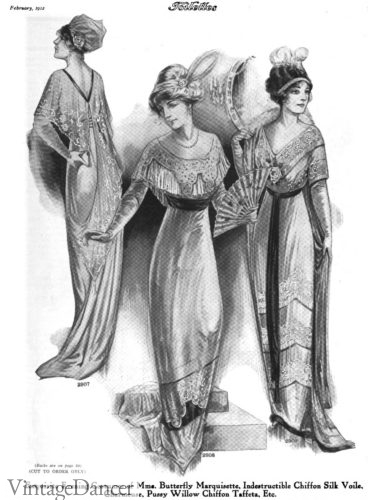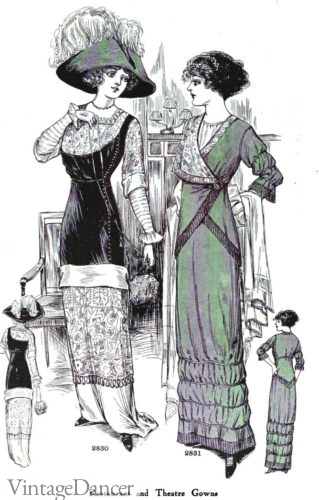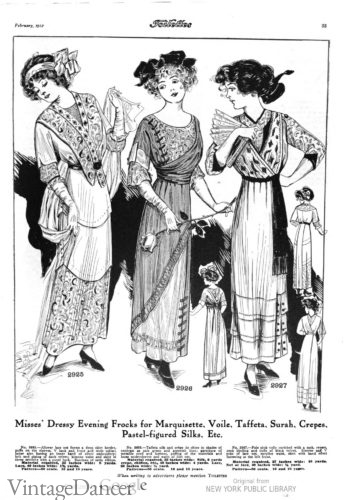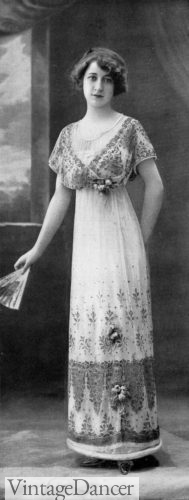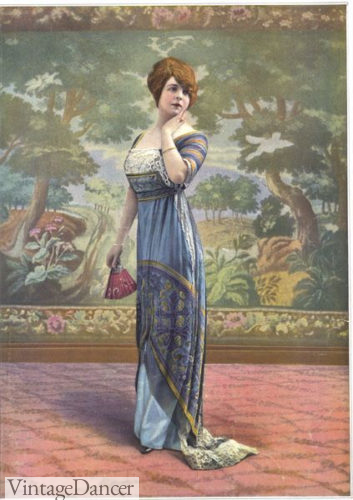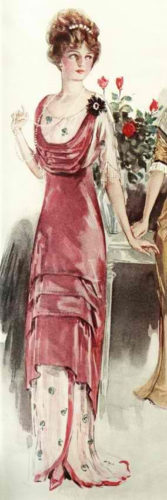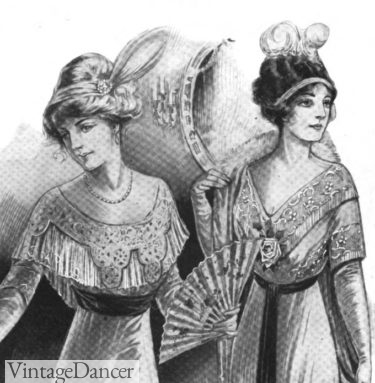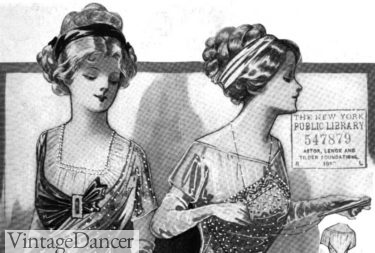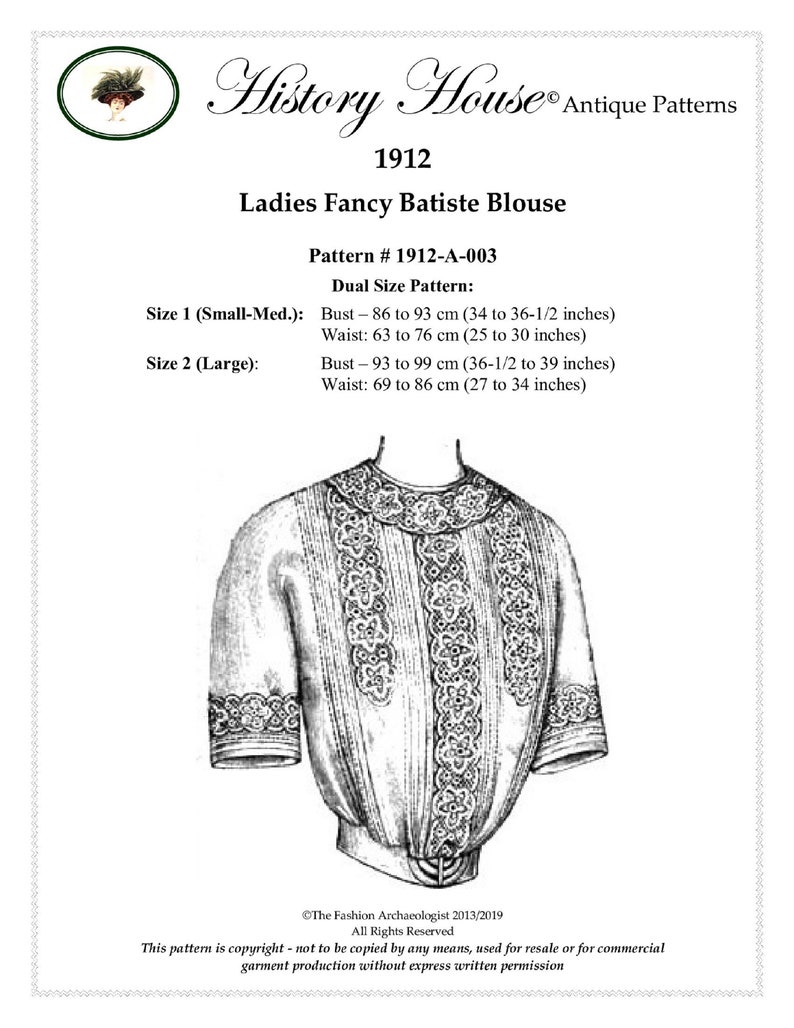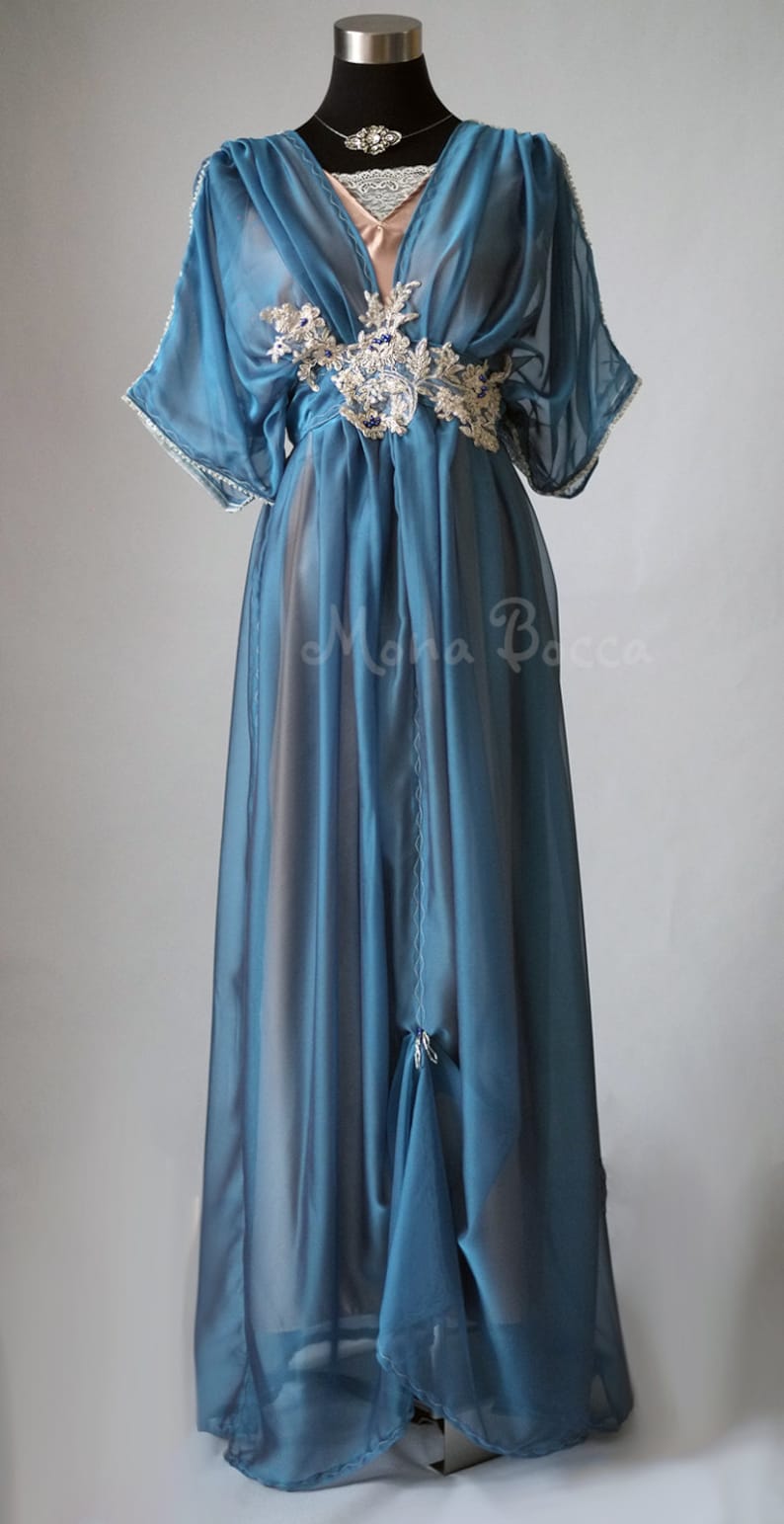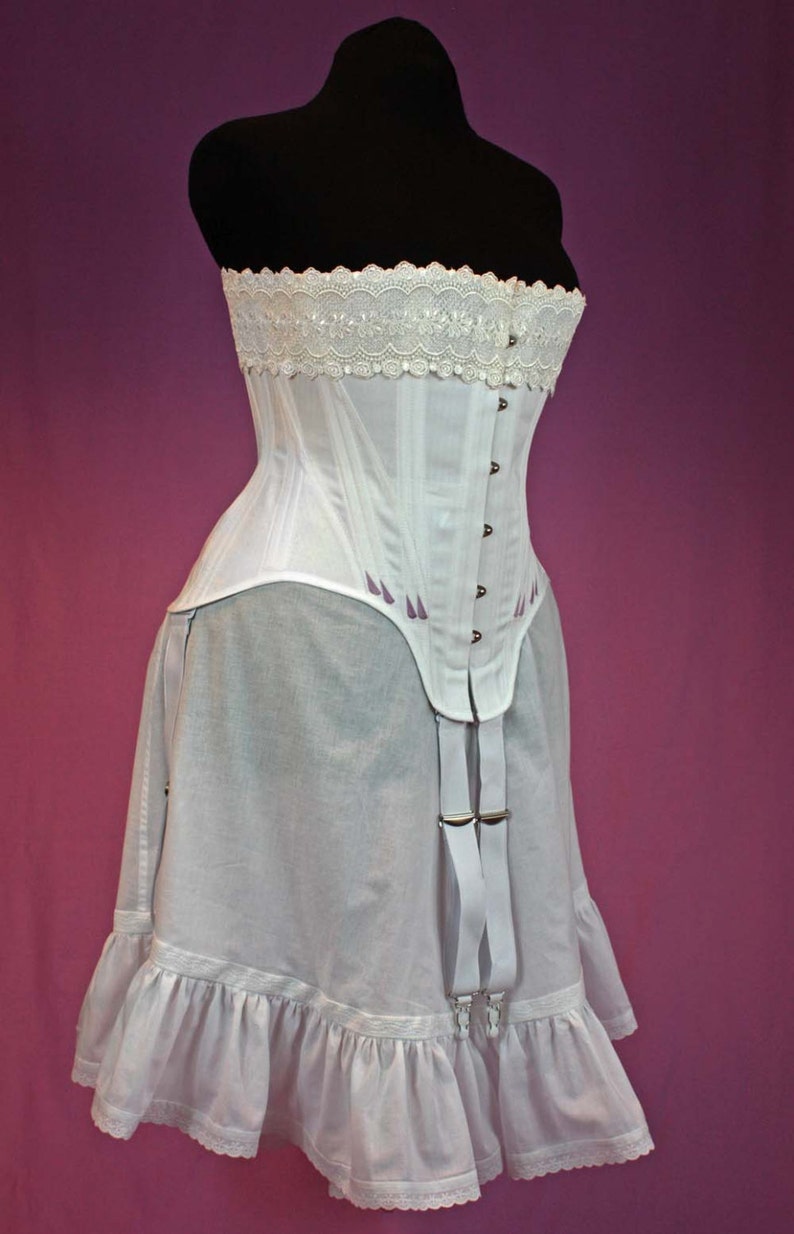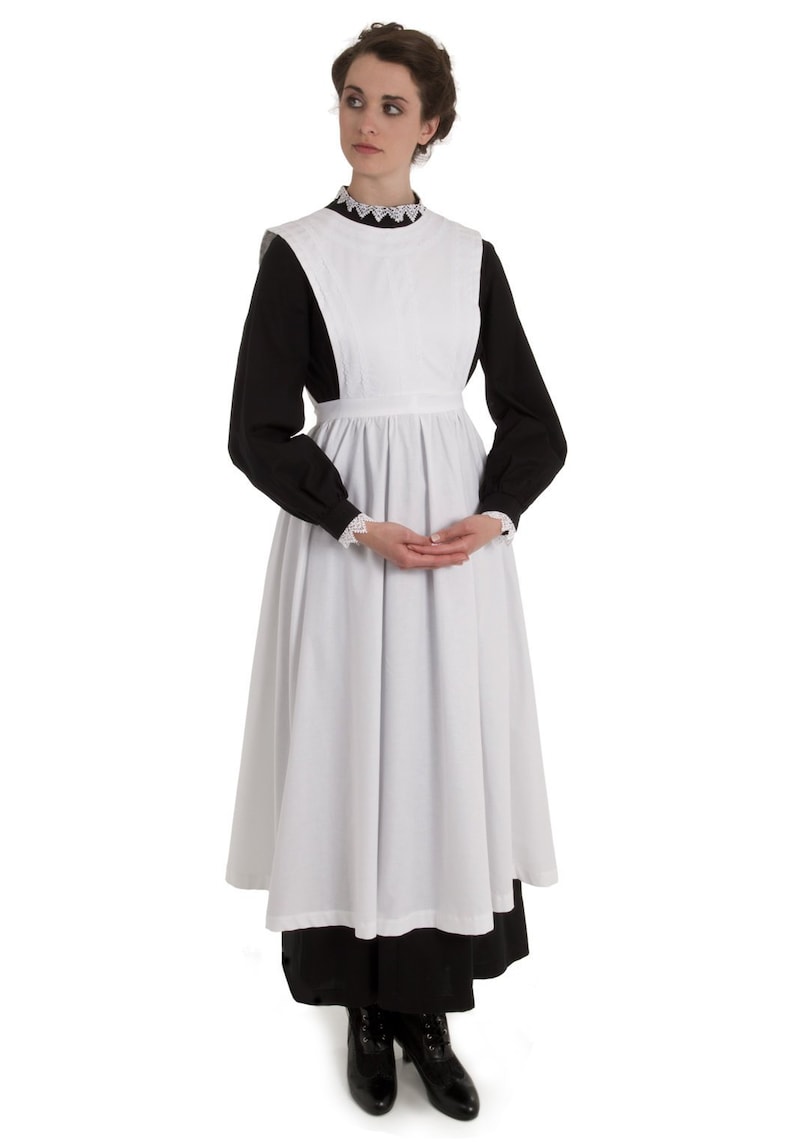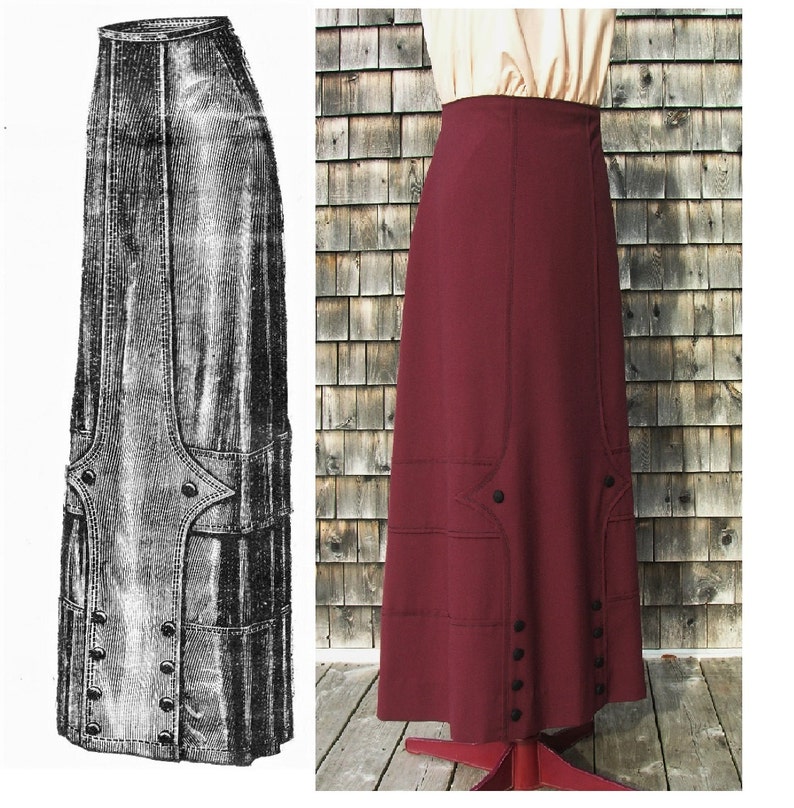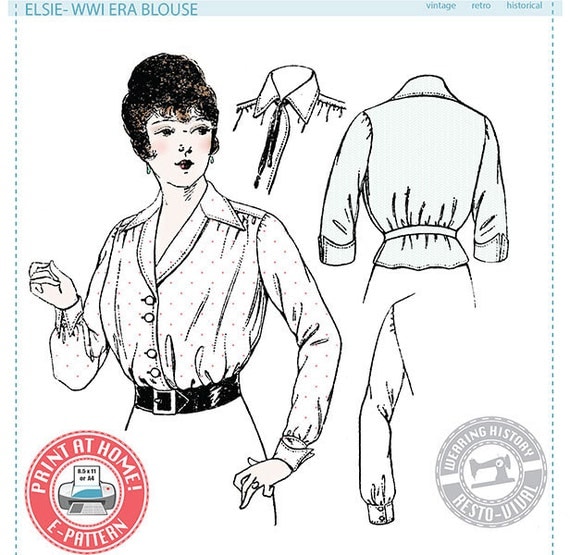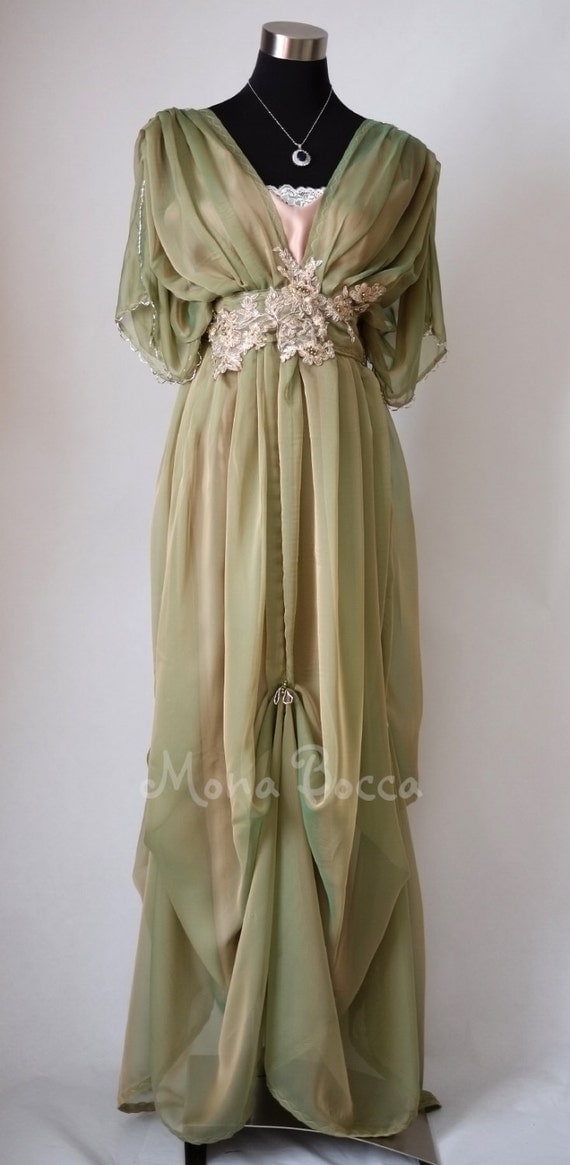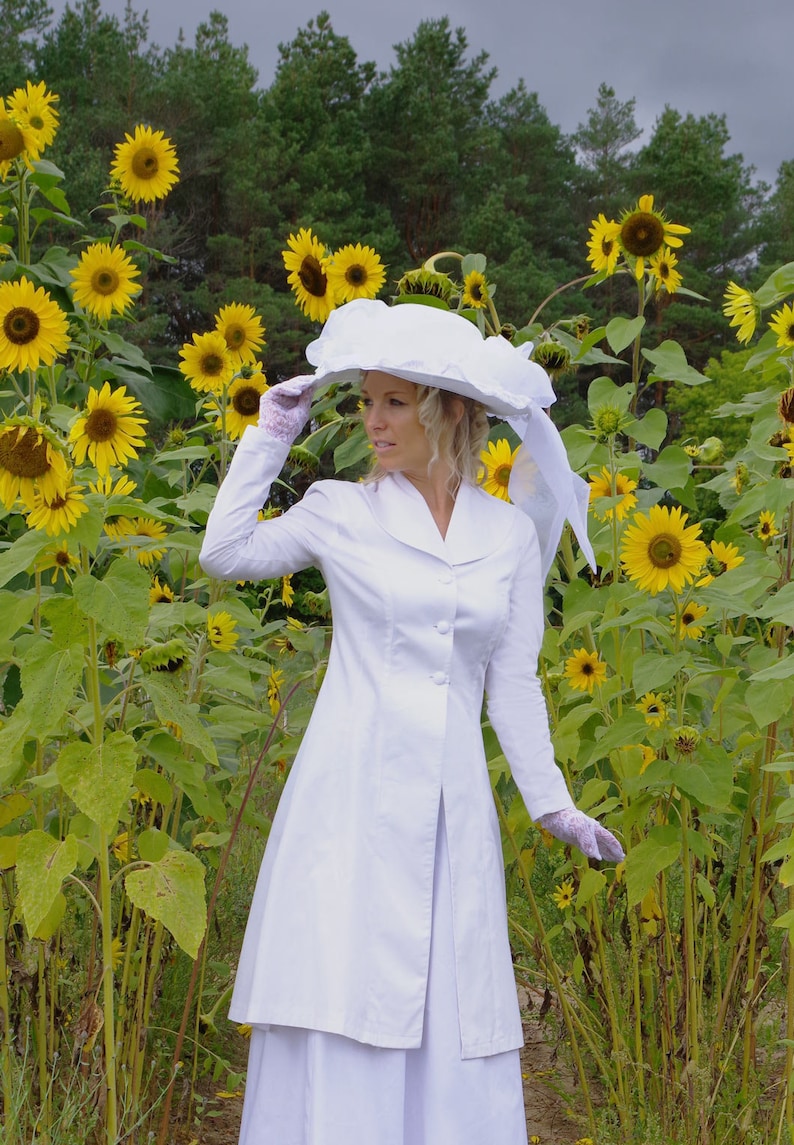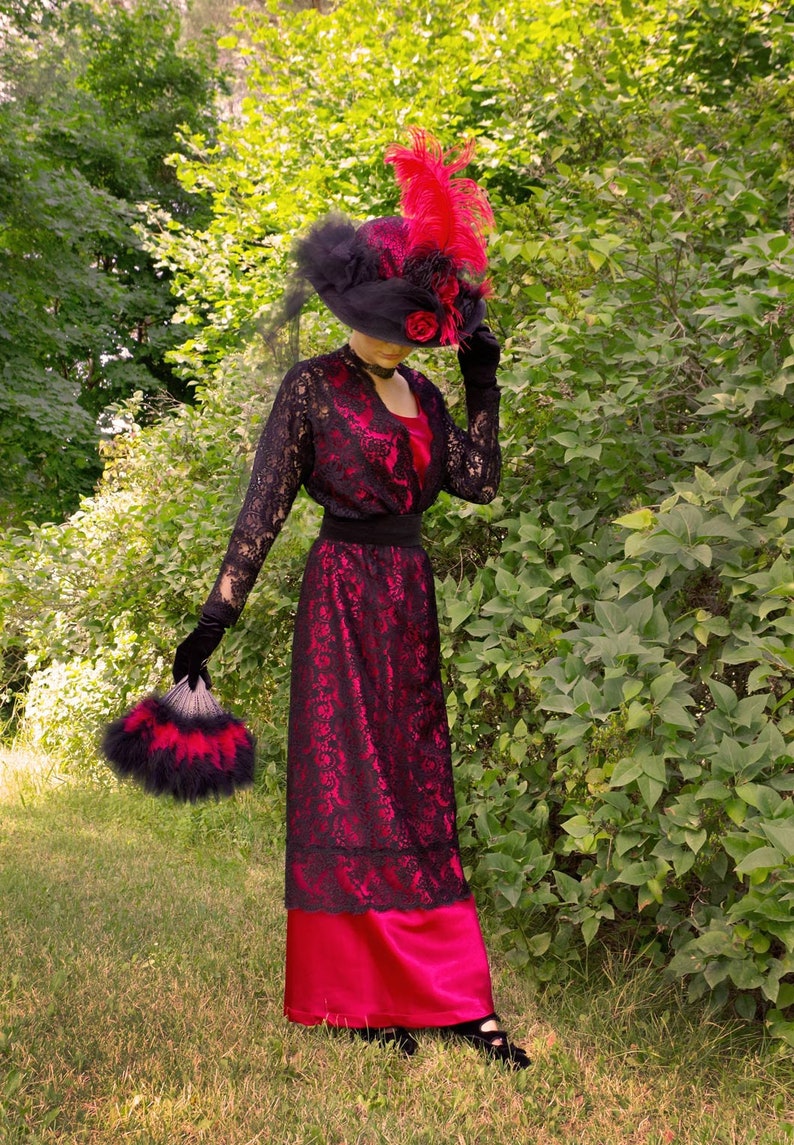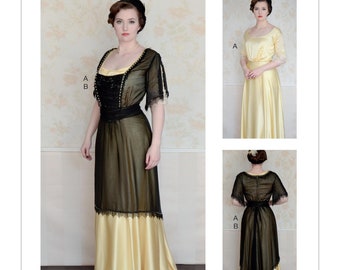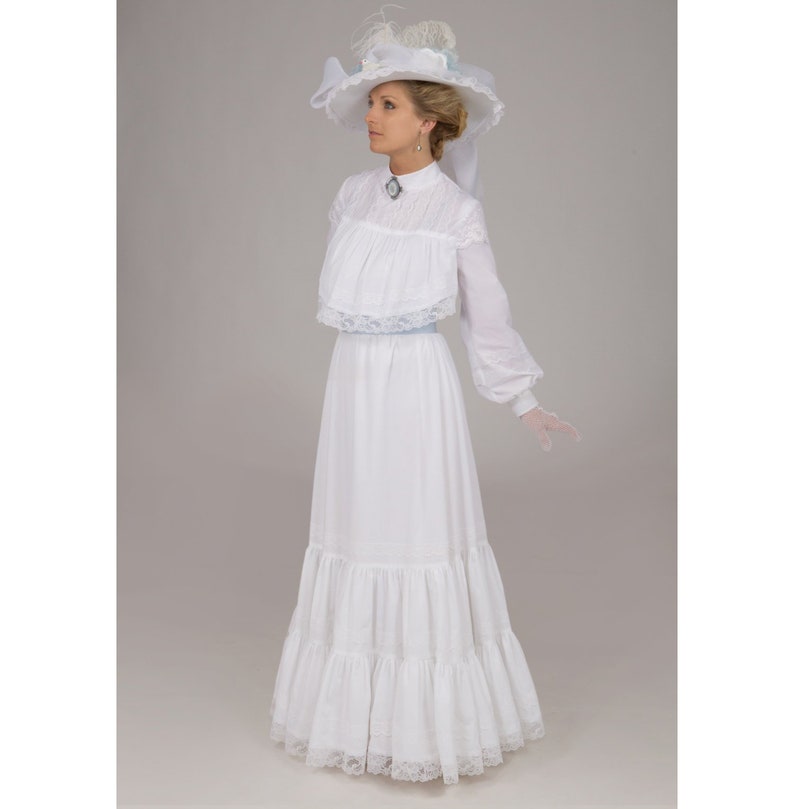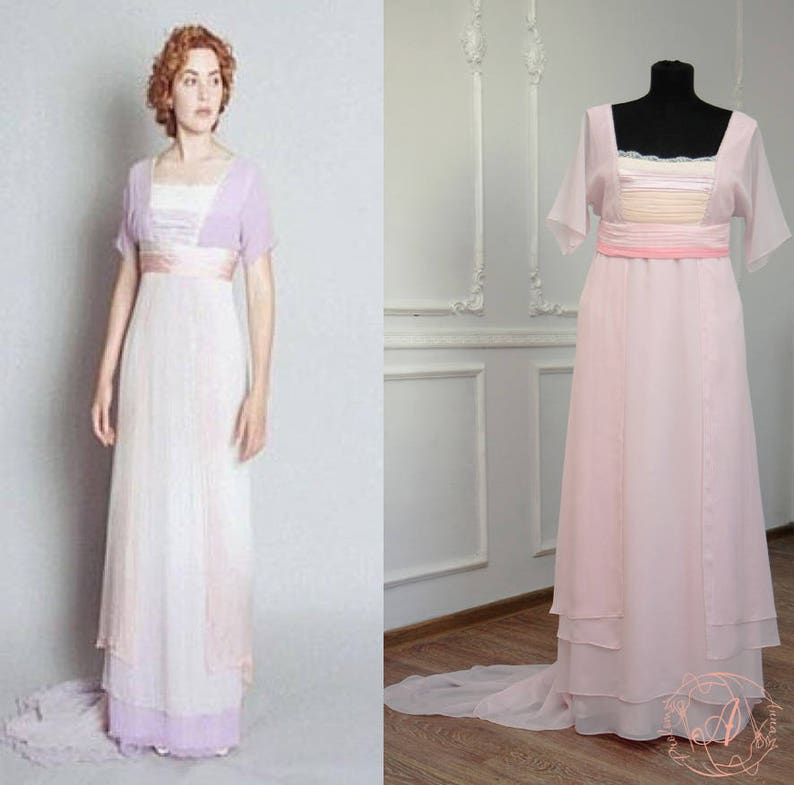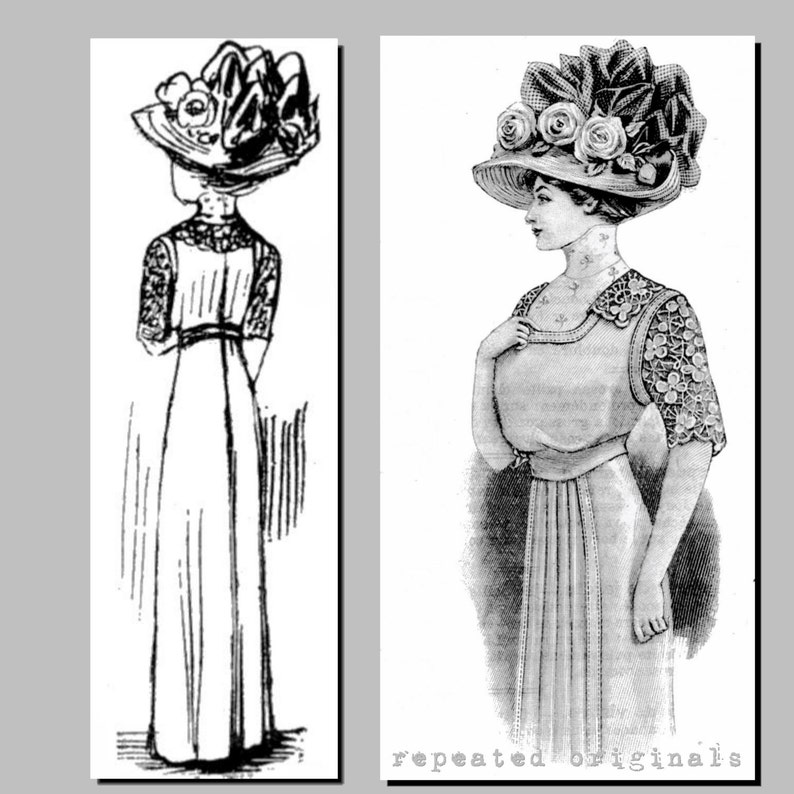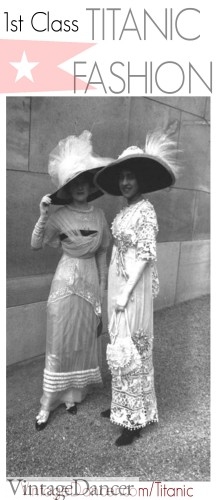
Pin this!
Despite more than 100 years passing since the tragedy of the Titanic, the story of it remains timeless. For those of you who are lucky enough to be attending a Titanic-themed event, this 3 part guide will help you learn about 1st class women’s fashion, 2nd and 3rd class women’s fashion, and costume ideas for all budgets. For men, I already have a great article on dressing first class for a formal dinner and day wear. More tips on dressing 2nd and 3rd class for men can be found here.
First, let us take a look at every woman’s favorite — first class passenger Titanic fashion!
Dressing On the Titanic—1st Class Women
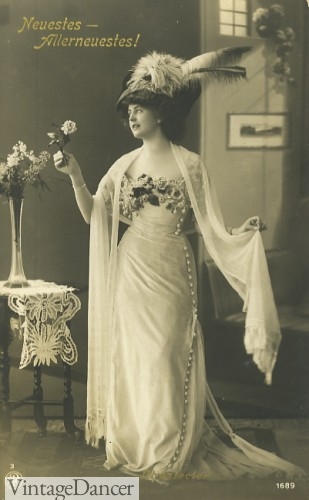
1910 gown with shawl
For passengers on the Titanic, especially first and second class ticket-bearers, the trip wasn’t just method of travel from one place to another, but a lavish five-day party. Women would be changing clothes at least four times a day according to social conventions, and the multiple layers of underwear included meant that many first class ladies took a lady’s maid with them on the voyage. An example of the average day would be going to breakfast in a simple dress or tailored suit, wearing a “tea gown” for tea (the less-affluent wore a summer frock), and wearing a different dinner dress for each night.
Fun fact: The largest claim filed against White Star Line was made by Charlotte Drake Cardeza, which ran up to eighteen pages and included fourteen trunks, four bags, a jewel case, and a packing case, racking up to a grand total $3,538,694.27 today.
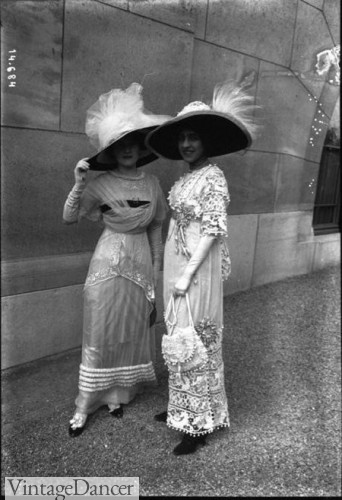
1st Class ladies about to set sail (date unknown, roughly 1910-1913)
1912 fashions marked a gradual transition from the ultra-feminine, S-shaped silhouettes of the Edwardian Era (and its subset La Belle Époque) to the straighter, more boyish silhouettes of the Roarin’ Twenties. Lady Duff Gordon (later known by her couturier name Lucile) and Paul Poiret were among the well-known and forward-thinking designers of the era, and are credited with contributing to and creating a lot of the trends of the day.
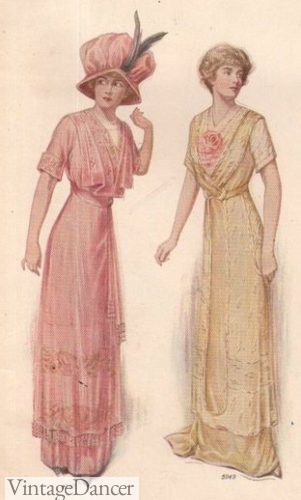
1911 chiffon afternoon dresses
Clothing was quite detailed, as Edwardian blouses would also have many tucks and ruffles and dresses would have exquisite hand beading. Along with the popularity of fur, elaborate hats, and expensive jewelry, you can clearly see that 1912 fashion was about extravagance and showing off wealth.
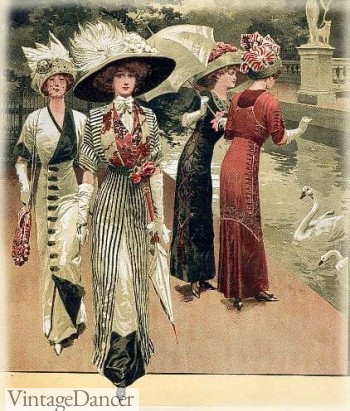
1912 traveling /walking dresses
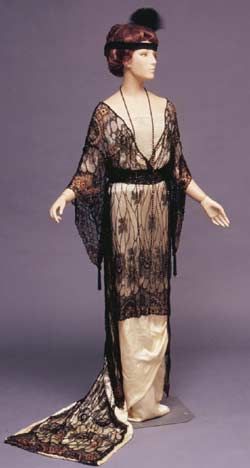
1911, Kimono style gown. Source Herbert F Johnson Museum of Art
However, in contrast with the very English Edwardian style of clothing, oriental influences began to rise in popularity during the time as well. Japan played a large role, and while men enjoyed collecting Japanese artifacts, women preferred to pay their attentions to the lightweight silk kimono-style dresses (most of Rose’s day dresses in the Titanic film were kimono style). T-shaped and floor length, the kimono also influenced men’s smoking jackets as well, as they took on the crossed over, one-button fastening of Japanese robes. For women’s dresses, the colors were typically lighter pastels, but for the more radical, stronger reds or turquoise blues were also in vogue.
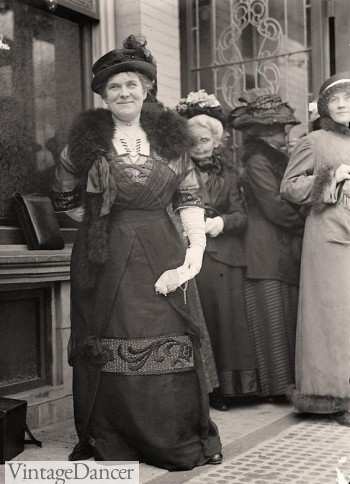
Mature women’s fashion. Daniels, Mrs. Josephus. Mrs. Woodrow Wilson First Breakfast. It was created in 1913 by Harris & Ewing.
Still, many trends such as Eastern-inspired dresses and straighter silhouettes were mostly worn by younger wealthy women. The wealthy mature women stuck with fashions that were popular during the earlier Edwardian times — large blouses with puffy shoulders and long, narrow sleeves paired with full-length ruffled skirts and many petticoats. Those that kept in current trends followed similar silhouettes but in darker colors, less restrictive skirts, smaller hats, simple ornamentation, and usually longer sleeves. Accessories were a mature woman’s splurge. Expensive furs, large heavy jewelry, and richer fabrics were always worn.
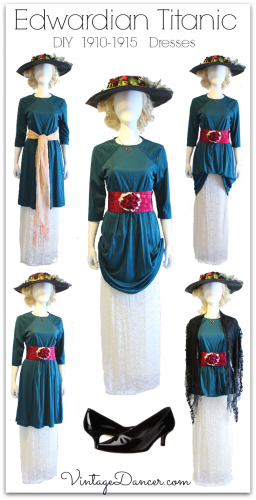
Titanic costume varieties by gathering the over dress in several ways. See this and more DIY dress ideas.
Titanic Fashion – Morning Dress
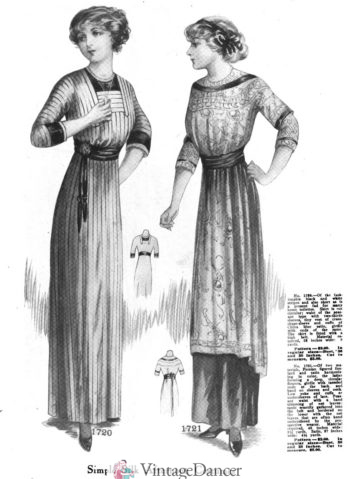
1911, Simple dresses for morning and early afternoon
Although some First Class passengers had breakfast in their lavish Staterooms, tailor-made suits were the most sensible outfit choice for the morning — practical and designed for comfortable travel, especially as the ship was heading into the colder climate up in the Northern Atlantic.
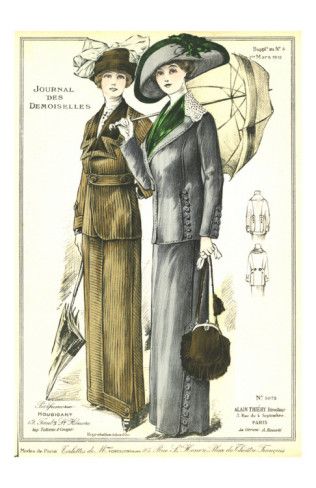
1912 Tailored Suits
Tailor-made suits first emerged during the 1880s and were typically made of tweed, face-cloth, or worsted wool. They were designed to fit the wearer like a glove. The standard tailor-made suit consisted of a straight line hobble skirt, a jacket, and a crisp white blouse. Hobble skirts were severely limiting since they tapered down to a very narrow opening just at the ankles, so most women incorporated flat pleats or slits towards the hemline to help with walking. The hemline also rose to ankle height.
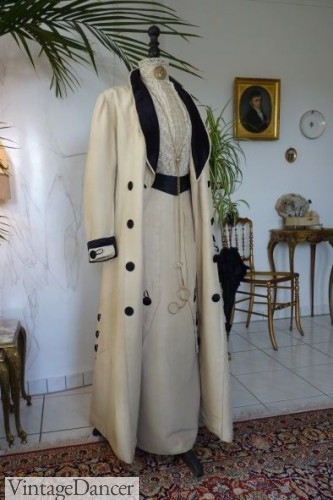
Edwardian Walking Suit, circa 1912 (Sold by Antique gown)
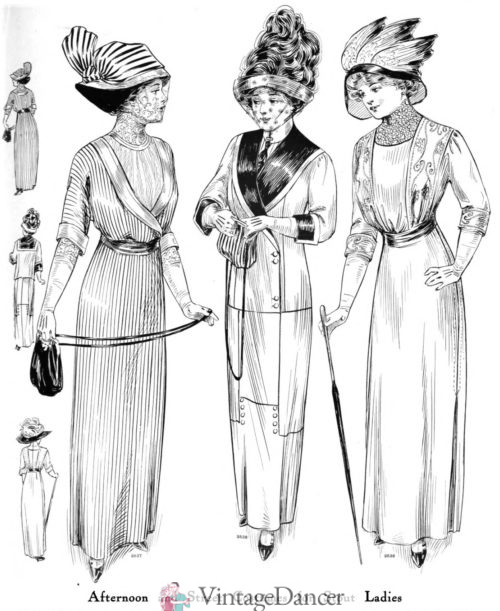
1911 suits and dresses for travel or walking, plus sizes
As for the torso, the jackets tended to be long and loose at the waist, extending below the hips, and asymmetrical in cut (though decoration was minimal). Common colors were muted browns, greys, and navy. The white blouses worn underneath, as mentioned before, had many tucks and ruffles, and also featured Edwardian high collars with wires inside to keep them upright. It was only later that lower collars such as the Quaker girl collar and the Peter Pan neck became more fashionable, partially due to the efforts of Lady Duff Gordon. Shop Edwardian inspired blouses and skirts.
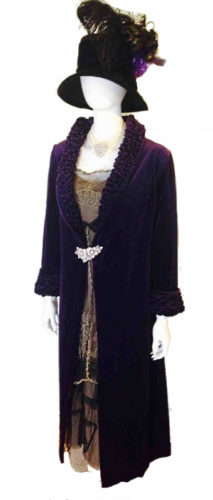
DIY velvet coat made from a bathrobe, over a Nataya dress, paired with a hat and feather plumes.
Shoes with laces or leather boots (sometimes with two contrasting colors) were typically worn with the tailor-made suit, and heels were usually low to match the practicality of the suit itself. The fashion-conscious may have chosen narrow high-heeled shoes, and some others may have chosen black patent leather shoes with a square buckle at the front. Learn more about Edwardian era women’s shoes and shop boots and shoes.
- 1912 Ladies button up boots
- 1912 oxfords and slippers
- 1912 Slippers for day and evening
Women’s Gloves
Traditional etiquette rules dictated that women had to wear gloves in public, unless at meal times. This was because physical contact (except in private situations) was inappropriate, and therefore gloves made certain types of contact, such as handshaking, acceptable.
Elbow-length, made of thin kid leather or suede, fastened with a row of buttons, and cut extremely tight, gloves came mostly in browns or greys for outdoor day wear or white for indoors and in summer. Over the elbow gloves were worn with short sleeved dresses, including most evening gowns. Wrist length gloves were acceptable with long sleeved dresses. Fur-lined gloves were also used for warmth during the winter, and lace gloves were worn for their breathability in the summer. Although the task of putting on gloves was time-consuming, as they could take up to twenty minutes to put on due to the tight fit and rows of buttons, they still needed to be changed multiple times during the day since they quickly got dirty.
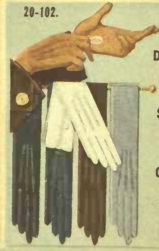
1913 long gloves
Women’s Titanic Hats
Hats were also a part of social etiquette, and generally all women wore them. Although the size and lavishness of hats had reached its peak in 1910, they were still quite decorated and relatively big in 1912. Although the hats worn with the practical tailor-made suits were smaller and made of felt, women still often wore more elaborate hats with all outfits. Ostrich feathers were a popular trimming, but aigrette (egret) or birds-of-paradise plumage were also in use. Along with the feathers, silk and velvet hat ribbon trimmings were also prevalent, typically in darker colors.
Read more about Titanic Era Hat fashion. Shop Titanic era inspired hats.
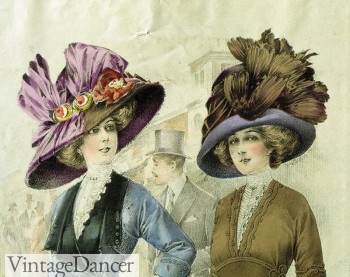
1911 Large picture hats
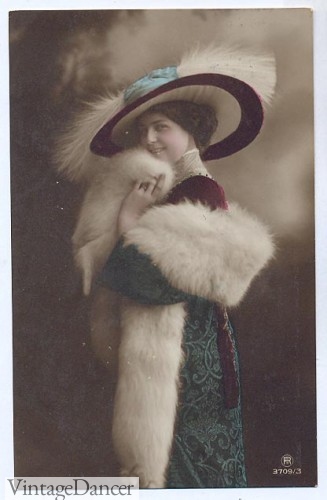
1910 Velvet trimmed wide picture hat
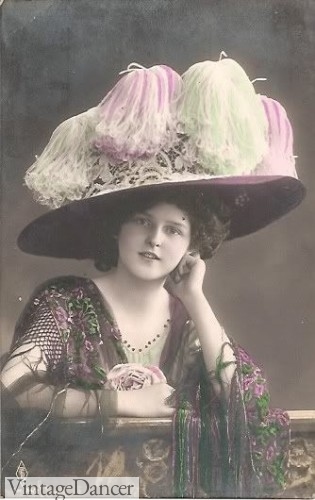
Wow! Ostrich plumes topped picture hat
Parasols
Fair skin in the Edwardian era indicated wealth and status, as it showed that the person wasn’t a commoner who had to work in the sun. Parasols were therefore important in maintaining the coveted porcelain complexion, and a lady always carried one with her while traveling outdoors. Although they were functional, they also had to reflect the wealth of the carrier and often came in fussy lace styles, although solid fabric ones were also available. Shop parasols.

1911 walking gowns with matching lace and flower topped parasol
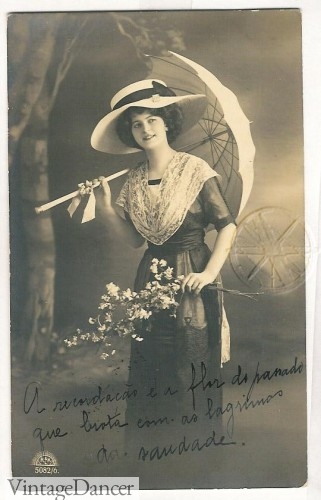
1913, Simple Summer Parasol
Coats and Shawls
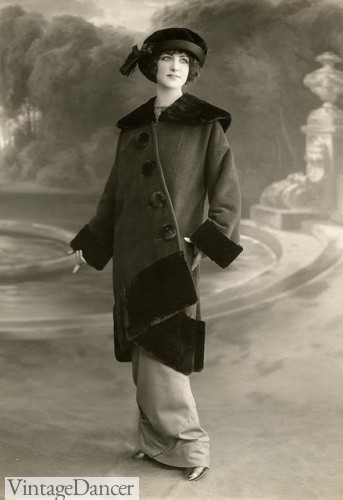
1912 Fur lined Asian inspired, cocoon shaped coat.
Once again, fur was quite fashionable during this time, and as the weather became colder as the Titanic headed north, passengers needed the warmth. A winter coat was full-length and made of thick wool, could be double or single-breasted, and came in a variety of colors from camel to black (Rose’s pink coat is in this style). In order to show off wealth, some coats were three quarters or fully made of fur, but many also only had fur trim. The fur on the coats ranged from seal to lamb to chinchilla.
“Coats and sets” were also sold, the set being fur accessories worn with the coat. Sets usually consisted of a stole and a hand muff, and these were made of the entire pelt of the animal (meaning the heads and tails as well). These generous fur pieces left an even greater impression of wealth.
Lighter weight coats were worn inside or out in nicer weather. They were often silk or velvet in a cocoon shape and had a single large clasp as the low hip. Tassels often tipped the front ends. The kimono coat with large loose sleeves and Asian prints was very popular at this time as well. They were frequently worn over dinner gowns as passengers made their way to and from dinner.
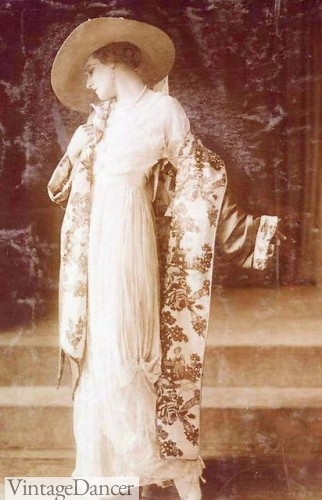
Lucile (Lady Duff Gordon), c. 1910, dress with Asian print kimono coat
Before the weather became terribly cold, a silk embroidered shawl could be worn aboard as temperature gradually got cooler—both during the day and evening. Silk shawls or wraps were solid or patterned, decorated with tassels or a beaded fringe along the bottom. These shawls also varied in size, coming in both standard size (like today’s wraps) or larger cocoon-shaped varieties.
Shop shawls, wraps and kimono coats.
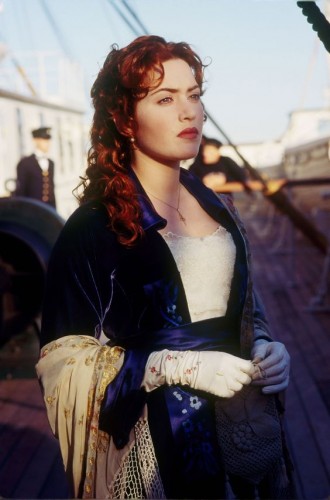
Rose, Titanic movie, caring a silk and embroidered fringe shawl.
Lunch or Afternoon Tea Dresses

Day dress, 1911, Plum silk with chemise detailing. Source Stickley Museum
Contrary to lunch nowadays, lunch on the Titanic was quite a formal affair, consisting of at least three courses and lasting up to two hours. For lunch, women would change out of their practical tailor-made suits and into more formal dress. Along with having straighter silhouettes, these dresses had fairly high waistlines, V-shaped necklines that were sometimes crossed over, and elbow length sleeves. Due to these more open necklines, the dresses were also worn with a separate upper chest covering, called chemisettes, or semi-transparent in-fills. Modesty was important for all daytime gatherings.
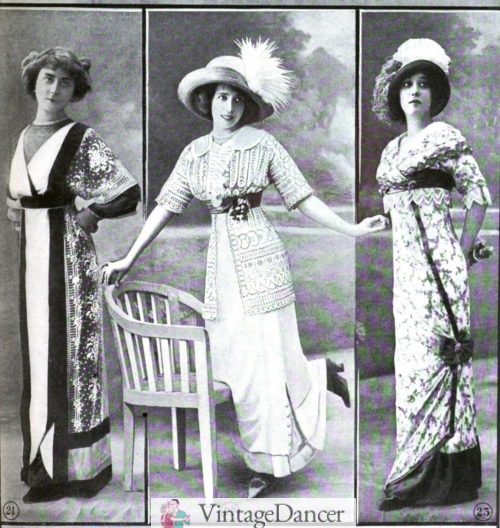
1911 late afternoon and early evening dresses
Although skirts followed the trend of being narrower (with pleats and slits to make them more comfortable, of course), they were decorated with tunic layers or asymmetrical draping, often including a small train. These dresses were not in soft pastel colors, but rather in blues, dark reds, greens, and purples, with velvet being a popular fabric.
A certain type of tea dress was worn during tea. It was looser in fit, almost robe like, and worn without a corset (gasp!). In summer or for outdoor teas, a white tea dress made of lace or light cotton was expected. These dresses had a long and naughty history before the Edwardians made it an official public style, worn between lunch and dinner (around 5 o’clock) to allow the body to breathe and relax before dressing up for dinner. Learn more about the history of tea gowns.

1912, Traditional white tea dresses
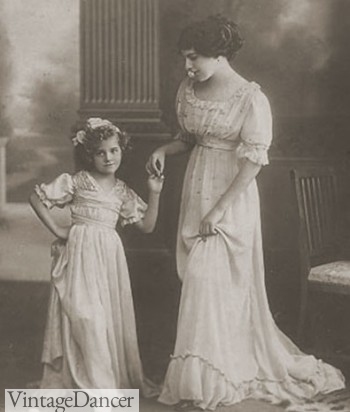
A tea dress for mother and child
Accessories worn with these dresses were simple brooches at the neck or on the bodice, or a long string of beads as a necklace. Lighter-weight shoes were to be worn with these outfits, typically being fabric-covered, with lower Louis heels and high tongues. Hats were obviously worn as well, and they were similarly smaller, made of felt, and featured upturned brims with aigrette (egret) or osprey feathers. If lighter colored gloves weren’t worn with the elbow-length sleeves of the dresses, gauze or chiffon undersleeves were worn.
Shop Edwardian inspired day, afternoon, or tea dresses.
For young girls, dressing like their mothers was expected from age 12 onward. Little girls wore lace tea dresses as well as sailor themed play clothes with white stockings and button up boots. Look here for 1910s era children’s clothing.
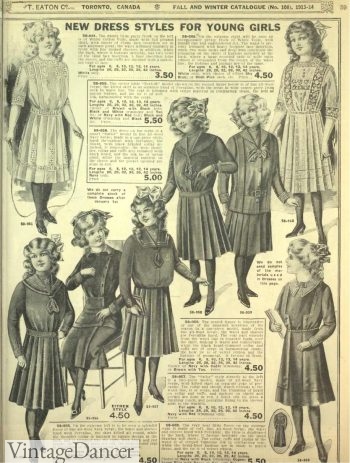
1913 young girls dresses
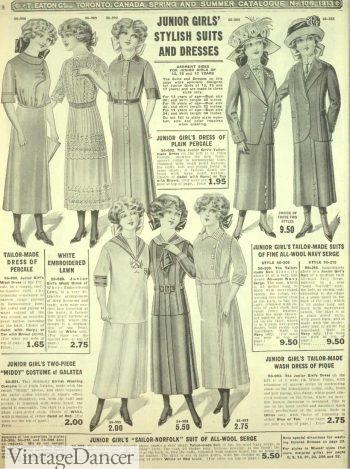
1913 Older girls dresses
Titanic Fashion – Dinner Gowns
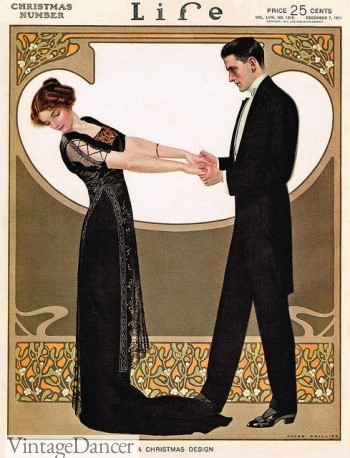
December 1911 Formal Dinner Dress – Life Magazine
Dinners on the Titanic were the peak of opulence on the journey, and the highly formal event meant that many first-class women wore a different dress each night. From the undergarments to the overskirts, every piece of the outfit was switched for more luxurious fabrics and styles—silk chemises instead of cotton, more elegant corsets, and silk stockings rather than wool. Similarly, due to the trending streamlined silhouette, petticoats made of crêpe de chine or Japanese silk were worn.
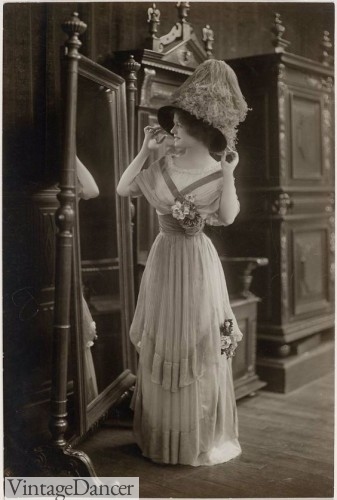
1910 wrap over dress, still popular in 1912.
Like the dresses worn to lunch, the bodices of the gowns worn for dinner had a crossed-over style, and the lower necklines and shorter sleeves meant that semi-transparent tulle or silk chiffon were worn under for modesty. Waistlines still remained at the high Empire-style, and although skirts were still fairly straight, overskirts, draping and tunics often were layered on top. The styles were inspired by Grecian art and Asian costume. Other decorations consisted of lace, embroidery, fabric flowers, and bows. Colors were much bolder than previous years, and although dresses in softer colors were still common, rich reds, blues, turquoise, gold, and greens were gaining in popularity. The most opulent fabrics were silk satin, chiffon, gauze, velvet, and brocade.
- 1912 Beaded evening dress
- 1912 Chiffon evening dresses
- 1912 dinner and opera dresses
- 1912 dancing dresses
In 1912, beading was added extensively all over some gowns or as a sheer layer over the main dress. The beading matched the color and tone of the dress. Sleeves were often short, exposing a bit of shoulder for young, single women. Necklines were also lower in a V, scoop, or square neckline.
Shop formal Titanic era inspired dresses.
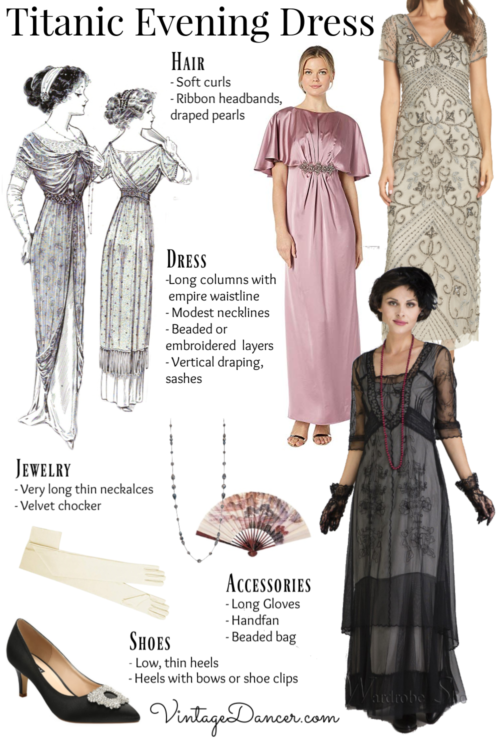
1912 evening dress and accessories guide
For the mature woman, she could wear these new revealing styles of dress but often preferred gowns in the style a few years earlier. It was a classic hourglass silhouette with a high bust line, narrow waist, and full hips expending down in an A-line skirt. For women who had grown up in earlier Victorian times, this style was closer to home. The new styles were thin, clingy, and form fitting — perfect for the young, but a bit too daring for Victorians. Talented fashion designers often blended the two styles to accommodate a mature figure with newer details.
Shop Titanic inspired plus size dresses.
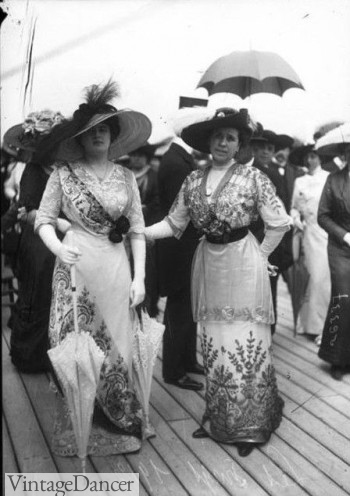
1910 Stylish ladies in 1st class wearing newer style gowns
Learn more about Edwardian evening dresses.
- 1910 Dinner dress by Beer
- 1912 Dinner gown by Bernard
- 1912 Titanic Evening Dress
Shoes worn to dinner didn’t deviate far from shoes worn to lunch, as they featured the low Louis-style heel, almond shaped toes, and high tongues, but they also sometimes had jeweled buckles. Silk or satin slippers were dyed to match dresses. The mule slipper became popular for semi-formal occasions (not dancing).
Jewelry was much more extravagant for the evening, however, and along with diamonds, pearls, and jet beads (sometimes paired with a choker), women were adorned with hair ornaments, long drop earrings, bracelets, and rings. Diamonds were the richest jewel. The more the better, just as large colored gem rings sparkled on multiple fingers. Shop Edwardian era inspired costume jewelry.
Hairstyles were decorated with fall feathers, ribbon circled or woven into a full head of curls, and stands of pearls artful placed around the crown.
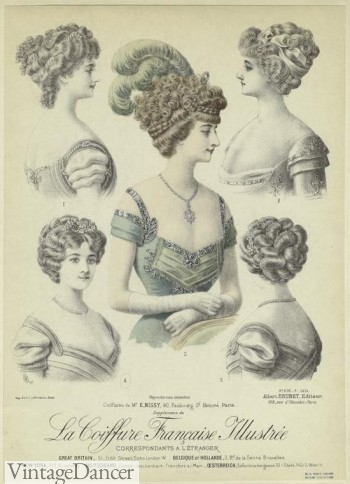
1911 Hairstyles as big as Hats! Large feather plumes, strings of pearls or gems and silk ribbon accented evening hairstyles which were all curl or waves.
- Feather and headbands
- Headbands 1911
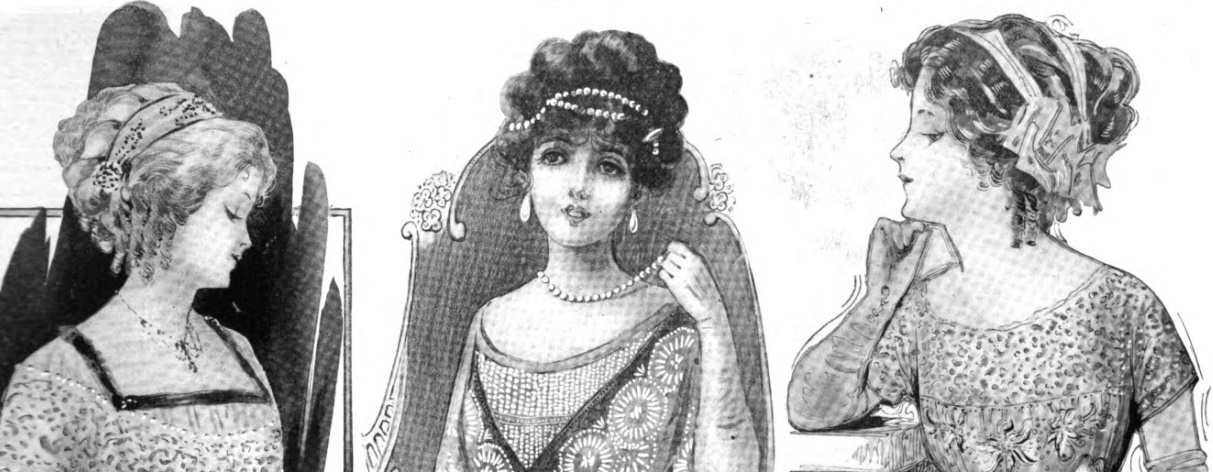
Headband, pearls, ribbon
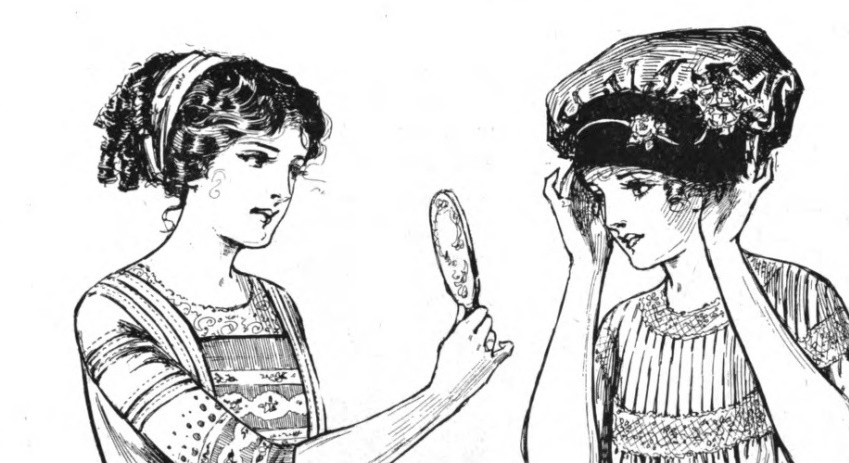
A headband and a turban hat
And that concludes this overview of first-class passenger attire.
For further reading:
- How to Dress for a Titanic Event – What to wear for a formal Edwardian Titanic era event.
- Shop Titanic Style Dresses (formal) or Day/Tea Dresses – Ready made dresses inspired by the era.
- How to Make a Quick Titanic Dress – Based on the movie dresses, how you can make dresses from your existing or thrift store clothing.
- DIY Easy Titanic Dresses – Even more ideas for turning modern clothing into Titanic era fashions.
- Sewing 1910s Dresses – History and guide to sewing your own Titanic era dress.
- Pinterest- Titanic Fashion and Clothing – 1910-1913 era historic clothing and photographs
- Titanic Style: Dress and Fashion on the Voyage – This book was very helpful in writing this article.
- Titanic 2nd and 3rd class Fashion – Part two of this series looking at what the middle and lower class passenger women wore.
- Titanic Era Children’s Clothing – Shop clothing and costumes suitable for a Titanic event. Read advice about boots for children.
Buy Titanic Era Dresses and Sewing Patterns
Debbie Sessions has been teaching fashion history and helping people dress for vintage themed events since 2009. She has turned a hobby into VintageDancer.com with hundreds of well researched articles and hand picked links to vintage inspired clothing online. She aims to make dressing accurately (or not) an affordable option for all. Oh, and she dances too.
